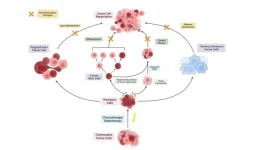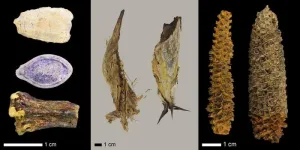(Press-News.org) Scientists at Stanford Medicine conducted a study describing a new category of depression — labeled the cognitive biotype — which accounts for 27% of depressed patients and is not effectively treated by commonly prescribed antidepressants.
Cognitive tasks showed that these patients have difficulty with the ability to plan ahead, display self-control, sustain focus despite distractions and suppress inappropriate behavior; imaging showed decreased activity in two brain regions responsible for those tasks.
Because depression has traditionally been defined as a mood disorder, doctors commonly prescribe antidepressants that target serotonin (known as selective serotonin reuptake inhibitors or SSRIs), but these are less effective for patients with cognitive dysfunction. Researchers said that targeting these cognitive dysfunctions with less commonly used antidepressants or other treatments may alleviate symptoms and help restore social and occupational abilities.
The study, published June 15 in JAMA Network Open, is part of a broader effort by neuroscientists to find treatments that target depression biotypes, according to the study’s senior author, Leanne Williams, PhD, the Vincent V.C. Woo Professor and professor of psychiatry and behavioral sciences.
“One of the big challenges is to find a new way to address what is currently a trial-and-error process so that more people can get better sooner,” Williams said. “Bringing in these objective cognitive measures like imaging will make sure we’re not using the same treatment on every patient.”
Finding the biotype
In the study, 1,008 adults with previously unmedicated major depressive disorder were randomly given one of three widely prescribed typical antidepressants: escitalopram (brand name Lexapro) or sertraline (Zoloft), which act on serotonin, or venlafaxine-XR (Effexor), which acts on both serotonin and norepinephrine. Seven hundred and twelve of the participants completed the eight-week regimen.
Before and after treatment with the antidepressants, the participants’ depressive symptoms were measured using two surveys — one, clinician-administered, and the other, a self-assessment, which included questions related to changes in sleep and eating. Measures on social and occupational functioning, as well as quality of life, were tracked as well.
The participants also completed a series of cognitive tests, before and after treatment, measuring verbal memory, working memory, decision speed and sustained attention, among other tasks.
Before treatment, scientists scanned 96 of the participants using functional magnetic resonance imaging as they engaged in a task called the “GoNoGo” that requires participants to press a button as quickly as possible when they see “Go” in green and to not press when they see “NoGo” in red. The fMRI tracked neuronal activity by measuring changes in blood oxygen levels, which showed levels of activity in different brain regions corresponding to Go or NoGo responses. Researchers then compared the participants’ images with those of individuals without depression.
The researchers found that 27% of the participants had more prominent symptoms of cognitive slowing and insomnia, impaired cognitive function on behavioral tests, as well as reduced activity in certain frontal brain regions — a profile they labeled the cognitive biotype.
“This study is crucial because psychiatrists have few measurement tools for depression to help make treatment decisions,” said Laura Hack, MD, PhD, the lead author of the study and an assistant professor of psychiatry and behavioral sciences. “It’s mostly making observations and self-report measures. Imaging while performing cognitive tasks is rather novel in depression treatment studies.”
Pre-treatment fMRI showed those with the cognitive biotype had significantly reduced activity in the dorsolateral prefrontal cortex and dorsal anterior cingulate regions during the GoNoGo task compared with the activity levels in participants who did not have the cognitive biotype. Together, the two regions form the cognitive control circuit, which is responsible for limiting unwanted or irrelevant thoughts and responses and improving goal selection, among other tasks.
After treatment, the researchers found that for the three antidepressants administered, the overall remission rates — the absence of overall depression symptoms — were 38.8% for participants with the newly discovered biotype and 47.7% for those without it. This difference was most prominent for sertraline, for which the remission rates were 35.9% and 50% for those with the biotype and those without, respectively.
“Depression presents in different ways in different people, but finding commonalities — like similar profiles of brain function — helps medical professionals effectively treat participants by individualizing care,” Williams said.
Depression isn’t one size fits all
Williams and Hack propose that behavior measurement and imaging could help diagnose depression biotypes and lead to better treatment. A patient could complete a survey on their own computer or in the doctor’s office, and if they are found to display a certain biotype, they might be referred to imaging for confirmation before undergoing treatment.
Researchers at the Stanford Center for Precision Mental Health and Wellness, which Williams directs, in partnership with the Stanford Translational Precision Mental Health Clinic, which Hack directs, are studying another medication — guanfacine — that specifically targets the dorsolateral prefrontal cortex region with support from Stanford University Innovative Medicines Accelerator. They believe this treatment could be more effective for patients with the cognitive subtype.
Williams and Hack hope to conduct studies with participants who have the cognitive biotype, comparing different types of medication with treatments such as transcranial magnetic stimulation and cognitive behavioral therapy. In transcranial magnetic stimulation, commonly referred to as TMS, magnetic fields stimulate nerve cells; in cognitive behavioral therapy, patients are taught to use problem-solving strategies to counter negative thoughts that contribute to both emotional dysregulation and loss of social and occupational abilities.
“I regularly witness the suffering, the loss of hope and the increase in suicidality that occurs when people are going through our trial-and-error process,” Hack said. “And it’s because we start with medications that have the same mechanism of action for everyone with depression, even though depression is quite heterogeneous. I think this study could help change that.”
Researchers from the Sierra-Pacific Mental Illness Research, Education and Clinical Center; the Veterans Affairs Palo Alto Health Care System; Brain Dynamic Centre, Westmead Institute for Medical Research; and the University of Sydney, Westmead, contributed to the work.
The study was funded through Brain Resource Company Operations Pty Ltd. and Stanford University’s Clinical and Translation Science Award Program overseen by the National Center for Advancing Translational Sciences at the National Institutes of Health (grant UL1TR003142-01).
END
Stanford Medicine-led research identifies a subtype of depression
Using surveys, cognitive tests and brain imaging, researchers have identified a type of depression that affects about a quarter of patients. The goal is to diagnose and treat the condition more precisely
2023-06-23
ELSE PRESS RELEASES FROM THIS DATE:
Stanford University’s Innovative Medicines Accelerator and Intonation Research Laboratories form a collaboration to fight cancerous neuroendocrine tumors
2023-06-23
Stanford University’s Innovative Medicines Accelerator (IMA) and Intonation Research Laboratories (Intonation) have formed a collaboration to develop treatments that target cancerous neuroendocrine tumors, or tumors that form from hormone-releasing cells.
The goal of the collaboration is to reduce the time and resources it takes to translate a biomedical breakthrough into a clinically and commercially viable medicine.
“I’m excited about this collaboration with Intonation Research Laboratories, which has the potential to speed ...
Extinct warbler’s genome sequenced from museum specimens
2023-06-23
The Bachman’s warbler, a songbird that was last seen in North America nearly 40 years ago, was a distinct species and not a hybrid of its two living sister species, according a new study in which the full genomes of seven museum specimens of the bird were sequenced. Genome comparisons of Bachman’s warbler with the golden-winged and blue-winged warblers also helped researchers identify a new candidate gene involved in feather pigmentation in the group. A paper describing the study, led by Penn State researchers, highlights the crucial role that museum collections can play in science and appears ...
Baylor researchers examine relationship between imprisoned mothers and their adolescent children’s risk behaviors
2023-06-23
WACO, Texas (June 23, 2023) – Women represent the fastest-growing population in U.S. institutional corrections facilities. In the past four decades, the number of women incarcerated has increased by more than 475%, rising from 26,326 in 1980 to 152,854 in 2020.Because the majority of imprisoned women are mothers, a conservative estimate indicates that at least one million American children have experienced maternal incarceration, and a substantial portion of them are adolescents.
Evidence suggests that maternal incarceration is a risk factor for adolescents’ ...
NSF CAREER Awardee develops a 1-minute frailty testing platform
2023-06-23
A layperson might think of “frail” as simply a synonym for “weak” or “fragile.” But in the medical field, frailty is a specific term, meaning – due to factors including inflammation and hormone shifts – a patient has a lack of physiological reserve, or a reduced ability to tolerate stress.
“That stress can be anything from the simple event of falling to getting COVID or another infectious disease,” said Nima Toosizadeh, assistant professor of biomedical engineering and medicine. “Or, it can be a treatment that might be invasive for patients. Knowing who can tolerate the stress is critical.”
It ...
Cancer cell repopulation after therapy: which is the mechanism?
2023-06-23
“Approaches targeted to prevent this post-therapy cancer cell repopulation should be uncovered to prevent tumor relapse and thus increase overall survival from this devastating disease.”
BUFFALO, NY- June 23, 2023 – A new research perspective was published in Oncoscience (Volume 10) on June 1, 2023, entitled, “Cancer cell repopulation after therapy: which is the mechanism?”
The past two decades have brought great progress in the treatment of cancer as patients with the disease live ...
Mario Romero-Ortega to lead Biomedical Engineering at the University of Arizona
2023-06-23
Mario Romero-Ortega was selected through a nationwide search to head the University of Arizona Department of Biomedical Engineering, beginning with the fall 2023 semester.
“I was drawn by the culture of collaboration, the quality of the students and faculty, and by the unified vision from University of Arizona leadership to impact biomedical engineering and health, from local to global,” he said.
Romero-Ortega will join the College of Engineering from the University of Houston, where he serves in the College of Engineering as a Cullen ...
When majority men respect minority women, groups communicate better
2023-06-23
Kyle Emich, a professor of management at the Alfred Lerner College of Business and Economics, along with Rachel Amey and Chad Forbes, then with UD’s Psychology and Brain Sciences Department, were searching for clues about why women’s knowledge often gets ignored in the workplace and how to improve the situation.
Drawing on both a problem-solving group exercise and measurements of brain activity, their findings, now published by the journal Small Group Research, illustrate ways stereotypes and attitudes can ...
Lessons in sustainability, evolution and human adaptation — courtesy of the Holocene
2023-06-23
The El Gigante rockshelter in western Honduras is among only a handful of archaeological sites in the Americas that contain well-preserved botanical remains spanning the last 11,000 years. Considered one of the most important archaeological sites discovered in Central America in the last 40 years, El Gigante was recently nominated as a UNESCO World Heritage site.
“No other location shows, as clearly as El Gigante,” state UNESCO materials about the site’s universal value, “the dynamic character of hunter-gatherer societies, and their adaptive way of life in the Central ...
New study reveals global reservoirs are becoming emptier
2023-06-23
Water is an essential and indispensable component of humanity’s everyday existence. As the global population grows and the climate warms, so does the water demand.
Over the past two decades, global reservoirs have become increasingly empty despite an overall increase in total storage capacity due to the construction of new reservoirs.
Led by Dr. Huilin Gao, associate professor in the Zachry Department of Civil and Environmental Engineering at Texas A&M University, researchers used a new approach with satellite data to estimate the storage variations ...
Mass General Brigham researchers uncover immune cell marker and regulator of anti-tumor immunity
2023-06-23
B cells are thought to play a critical role in innate and adaptive immunity, but their exact role in anti-tumor immunity remains unknown. Researchers at Brigham and Women’s Hospital with expertise in immunology collaborated with experts in dermatology from Massachusetts General Hospital to further understand the role of B cells and identify a subset of cells that may play a critical role. In collaboration with the Broad Institute they used a technique called single-cell profiling, which allows them to look at all the genes ...
LAST 30 PRESS RELEASES:
When is it time to jump? The boiling frog problem of AI use in physics education
Twitter data reveals partisan divide in understanding why pollen season's getting worse
AI is quick but risky for updating old software
Revolutionizing biosecurity: new multi-omics framework to transform invasive species management
From ancient herb to modern medicine: new review unveils the multi-targeted healing potential of Borago officinalis
Building a global scientific community: Biological Diversity Journal announces dual recruitment of Editorial Board and Youth Editorial Board members
Microbes that break down antibiotics help protect ecosystems under drug pollution
Smart biochar that remembers pollutants offers a new way to clean water and recycle biomass
Rice genes matter more than domestication in shaping plant microbiomes
Ticking time bomb: Some farmers report as many as 70 tick encounters over a 6-month period
Turning garden and crop waste into plastics
Scientists discover ‘platypus galaxies’ in the early universe
Seeing thyroid cancer in a new light: when AI meets label-free imaging in the operating room
Neutrophil-to-lymphocyte ratio may aid risk stratification in depressive disorder
2026 Seismological Society of America Annual Meeting
AI-powered ECG analysis offers promising path for early detection of chronic obstructive pulmonary disease, says Mount Sinai researchers
GIMM uncovers flaws in lab-grown heart cells and paves the way for improved treatments
Cracking the evolutionary code of sleep
Medications could help the aging brain cope with surgery, memory impairment
Back pain linked to worse sleep years later in men over 65, according to study
CDC urges ‘shared decision-making’ on some childhood vaccines; many unclear about what that means
New research finds that an ‘equal treatment’ approach to economic opportunity advertising can backfire
Researchers create shape-shifting, self-navigating microparticles
Science army mobilizes to map US soil microbiome
Researchers develop new tools to turn grain crops into biosensors
Do supervised consumption sites bring increased crime? Study suggests that’s a myth
New mass spec innovation could transform research
Maternal nativity, race, and ethnicity and infant mortality in the US
Migration-related trauma among asylum seekers exposed to the migrant protection protocols
Jupiter’s moon Europa has a seafloor that may be quiet and lifeless
[Press-News.org] Stanford Medicine-led research identifies a subtype of depressionUsing surveys, cognitive tests and brain imaging, researchers have identified a type of depression that affects about a quarter of patients. The goal is to diagnose and treat the condition more precisely




